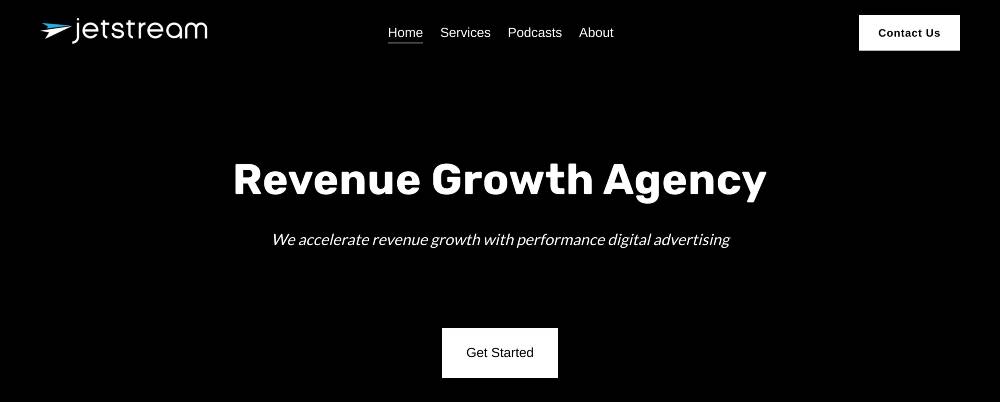Jetstream CEO Mike Williams on why startups should start marketing from day one
CEO Mike Williams shares how and why startups can bake marketing into their business from day one.

Marketing is a cornerstone of any business. It helps build brand awareness and plays a vital role in creating demand for the product or service. However, in the process of expanding, many startups overlook the importance of marketing and instead focus more on sales.
Speaking on a Crowdlinker podcast, Jetstream CEO Mike Williams affirms the need to prioritize marketing from day one.
Launched in November 2019, Jetstream, the marketing firm helps clients develop revenue growth strategies through a performance-based playbook. The agency creates digital strategies meant to align with each brand's revenue goals.
Mike shares that the idea to build Jetstream came after he served as a facilitator at Alacrity Canada, a non-profit that provides entrepreneurial mentorship and support to tech companies in Western Canada. Mike spearheaded the Digital Marketing Bootcamp, a virtual skills-training program that helps startups mix effective marketing in with their core business models.
Mike's goal was to build a bootcamp that could give founders a solid understanding of digital marketing concepts, while they built their products.
"A lot of them are super smart engineers and developers who are building great products that solve problems, but they do not understand marketing," he says plainly.
Several months after joining the non-profit and learning more about startups’ needs, Mike launched the for-profit Jetstream. In parallel, he continues to serve at Alacrity Canada.
Digital marketing fallacies

Before Alacrity Canada and Jetstream, Mike operated in digital marketing for nearly two decades. He is well-versed in its different facets, such as social media, search engine optimization (SEO), and content.
There are many different ways to get a company off the ground and make things happen, says the CEO. But he prefers to offer solutions that zero in on the early stages of a brand's marketing division.
Mike believes founders often fall back on what they know when they get stressed, or when things get tough. This can often mean that marketing ends up falling by the wayside.
"If you do not know a lot about the product, you will not go back to the product. If you are a developer or an engineer, you are not going back to marketing and sales. What you will do is focus on the product to make it better," he explains, pointing out a common fallacy.
60/40 sales-marketing mix

Mike suggests that 60/40 is the optimal balance between marketing and sales. But when he first started working with clients, he found that this wasn't the case. Often, clients focused more on sales than marketing.
"I want to get more marketing in the mix because there is so much scale in that. If we can get more marketing in there, we can scale up the business," he explains.
He clarifies that a business cannot scale up with marketing only. Indeed, sales will always be the lifeblood of any business. But great marketing makes sales easier and more efficient.
Because of this relationship, Mike encourages startups to put more weight on marketing than sales — resulting in that ideal 60/40 split.
“If you put a lot more effort into marketing, you can create more scale for your business. The challenge is putting a percentage on it. We might have ten marketing people to 50 salespeople, but the work of marketing people is more scalable," he adds.

Start your marketing early

From day one, the Jetstream team explains the importance of marketing to their clients and encourages them to start executing as early as possible.
Mike believes the first day of any business should be all about both marketing and sales. He adds that it is also very important to know whether your product can solve problems and whether there is a market big enough to sustain it.
A post-mortem study of more than 100 failed startups showed that 35% of them failed because there was no market need. It is vital to know if the market is big enough before you begin strategizing — nobody wants to create a product when only ten people will buy it.
Mike says that if there is a sustainable market for a product, startups should start reaching out to potential buyers, knowing their personas, and developing a targeted marketing strategy.

"It does not mean that you have to start building your Facebook page, TikTok, or SEO strategy. But from a marketing standpoint, you should ask whether anybody wants this. And how many people want this? Can I scale it?"
One essential component of marketing is positioning. Mike notes that positioning is something that often gets lost in startups.
For him, it's important to consider how a company will be positioned in the world — just because a product is working does not guarantee that your company will be in a good position to create a market and scale it. Therefore, he emphasizes the importance of having discussions about marketing and positioning early on.
"You have to create something compelling which has a unique selling proposition that resonates with people," he says.
Mike urges startups to focus on storytelling. In the digital realm, he ntoes that entrepreneurs often repeat A/B testing until results are obtained, without really thinking about psychology or messaging.
"My understanding of storytelling is to tell your story sooner and have it relate to your audience,” says Mike.
He adds that one way of doing this is by telling the story of the founder or the business. Not every founder will want to be the face of their brand. But if they're willing and able to do so, it may prove effective, as audiences will come to learn why they're pursuing a mission.
Finding the target demographic

To start finding his own target customers, Mike starts by finding out if someone is searching for a specific product. He explains that if customers are searching for it, there is already an intent. This increases the probability of gaining traction and achieving early success.
This can start with a paid search approach. It involves allocating an experimental budget to bump your company’s page to the top of Google's results page. You will only be charged when someone clicks on your link. In this way, brands can find out if there are people searching for the product or service you wish to provide in the first place.
Mike says, "I would go to a paid search approach before I invest in content and SEO. I want to see if there is volume, conversions, and traction before I start applying an organic search approach."
Using this method, entrepreneurs can discover customers who are already product-aware. These people can then be led through the journey of discovering your brand and understanding what makes you different.
If there is no search traffic, social media can be another option. It may be possible to discover new customers on the usual networks like Facebook, LinkedIn, TikTok, or Twitter.

The key difference between the two methods — search and social — is that the former show's a person's intent, whereas on social, people are often just surfing the feeds.
Mike also suggests doing discovery calls with prospects to learn what they truly need, and what will deliver the most value.
He remarks, "You will learn so much more about your customer if you ask them against making assumptions through discussions internally."
Mike’s marketing hacks
Last but not least, Mike shares two marketing hacks for startups:
- Find the traction. Mike encourages startups to keep pivoting until they find traction. He says, "I do not invest too much time unless I have traction. I will put a little time and effort into something. If it starts to go, then I will continue to travel down that path. If it does not have traction, I am not going to put more time and energy into it."
- Focus. "Focus on what you are doing, where you want to be." Mike says that he gets more excited about his business when he tries to focus on one thing. By truly focusing on tasks, founders can avoid falling into the common trap of saying 'yes' to too many things.
Save time and money when producing high-quality branded content. ContentGrow helps teams work with perfectly-matched freelance writers and journalists at preferred rates. Fill out the form below to get your own talent list or visit the site to get started.




